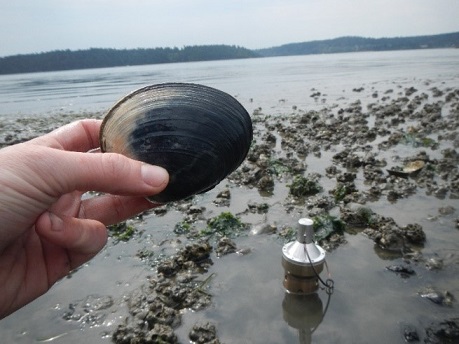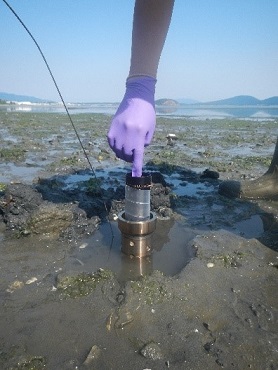Superfund Research Program
Model Predicts PAH Levels in Important Tribal Food Source
View Research Brief as PDF(474KB)
Release Date: 07/10/2019
![]() subscribe/listen via iTunes, download(8.8MB), Transcript(88KB)
subscribe/listen via iTunes, download(8.8MB), Transcript(88KB)
A sediment passive sampling model can be used to accurately predict the concentration of polycyclic aromatic hydrocarbons (PAHs) in butter clams, according to a recent Superfund Research Program (SRP) study.
PAHs are a large group of hazardous chemicals commonly found at Superfund sites and have been linked with health effects, including cancer. In Puget Sound, PAHs are found in the sediment where butter clams are harvested. Butter clams are an important food source and component of cultural practices for local tribes, but PAHs can accumulate in the edible portion, posing a health risk to the communities who rely on them.
Led by Kim Anderson, Ph.D., of the Oregon State University (OSU) SRP Center, the research team worked closely with tribal leaders to better predict PAH levels in butter clams while having a minimal impact on this important resource.
Passive Porewater Samplers

Traditional approaches to predict the levels of contaminants in sediment-dwelling organisms use measured total sediment concentrations and mathematically relate that to the amount that is likely to be readily taken up by the organism, a term known as bioavailability. According to the authors, this approach is not very accurate and tends to overestimate the amount of a chemical that will accumulate in animals by a factor of 10 to 44.
In contrast, the OSU team used sediment porewater passive samplers to measure freely dissolved PAHs, which may be a better indicator of bioavailability, accumulation, and toxicity for these organisms. Porewater is the water that exists between particles of soil and sediment. The researchers collected butter clams from four different tribal fishing sites selected by the community and placed their low-density polyethylene passive sampling devices (PSDs) in each of the empty clam holes for 29 days.
The team then compared the concentration of PAHs in the edible portion of the butter clams with the concentrations measured by the PSDs and used a mathematical model to predict PAH concentrations in butter clams based on PSD measurements.
Improving Exposure Predictions and Risk Estimates
Overall, the team detected 42 different PAHs in the porewater or clams and found similar profiles of PAHs in porewater and clams from the same site. The concentrations of PAHs in the porewater and clams were correlated, supporting the premise that the freely dissolved PAHs in the sediment porewater are likely to accumulate in clams.

Using the 42 detected PAHs, the team generated a mathematical model that could predict the concentration of PAHs in butter clams within a factor of 1.9 from the freely dissolved PAH concentration in porewater. Interestingly, in contrast to traditional models, this model suggests that PAH accumulation in clams does not continue to increase linearly as PAH concentration in porewater increases. Instead, at high PAH concentrations in porewater, the rate of PAH accumulation in clams decreases. According to the authors, this effect may represent biological processes that help organisms detoxify contaminants.
The passive sampling model developed by the OSU SRP team offers a sustainable, simple, and accurate approach to predict the concentration of PAHs in clams, the authors say. They argue that this tool is particularly important for assessing risk among Native American populations who consume more of these clams and other shellfish than the national average and, therefore, may be at greater risk for health impacts such as cancer.
Other Unique Passive Sampling Tools to Characterize Exposure
Anderson and her team also have collaborated with the Swinomish Indian Tribal Community to use personal passive sampling wristbands that she developed with SRP and other NIEHS funding to measure exposure to PAHs from nearby oil refineries.
Through this community-based participatory research project, the team observed differences in PAH exposure for individuals who participated in different activities or lived at different distances from the refineries. At the end of the study, participants reported that they felt more aware about their potential exposure to PAHs from different sources and, in many cases, felt empowered to take steps to reduce their exposure.
The silicone wristbands can capture and measure a large number of diverse compounds at environmentally relevant concentrations and have been shown to more accurately capture exposures in the body compared to traditional air monitors. Using these simple devices, the OSU team and colleagues from other institutions recently discovered common chemical exposures across continents. They detected 191 unique chemicals in 262 individuals in four countries. While chemical exposures varied among individuals, many were exposed to similar chemical mixtures. According to the team, these wristbands have been incredibly useful in uncovering personal chemical exposure trends that may help prioritize certain mixtures and chemical classes for future studies.
For More Information Contact:
Kim A Anderson
Oregon State University
Department of Environmental and Molecular Toxicology
1127 Ag Life Sciences Building
Corvallis, Oregon 97331
Phone: 541-737-8501
Email: kim.anderson@oregonstate.edu
To learn more about this research, please refer to the following sources:
- Dixon HM, Armstrong G, Barton ML, Bergmann AJ, Bondy M, Halbleib ML, Hamilton W, Haynes E, Herbstman JB, Hoffman PD, Jepson PC, Kile ML, Kincl L, Laurienti PJ, North P, Paulik LB, Petrosino J, Points GL, Poutasse C, Rohlman D, Scott RP, Smith BW, Tidwell LG, Walker C, Waters KM, Anderson KA. 2019. Discovery of common chemical exposures across three continents using silicone wristbands. R Soc Open Sci 6(2):181836. doi:10.1098/rsos.181836 PMID:30891293 PMCID:PMC6408398
- Minick DJ, Paulik LB, Smith BW, Scott RP, Kile ML, Rohlman D, Anderson KA. 2019. A passive sampling model to predict PAHs in butter clams (Saxidomus giganteus), a traditional food source for Native American tribes of the Salish Sea Region. Mar Pollut Bull 145:28-35. doi:10.1016/j.marpolbul.2019.05.020 PMID:31590789 PMCID:PMC7094077
- Rohlman D, Donatuto J, Heidt M, Barton ML, Campbell L, Anderson KA, Kile ML. 2019. A case study describing a community-engaged approach for evaluating polycyclic aromatic hydrocarbon exposure in a Native American community. Int J Environ Res Public Health 16(3):327. doi:10.3390/ijerph16030327 PMID:30682857
To receive monthly mailings of the Research Briefs, send your email address to srpinfo@niehs.nih.gov.


